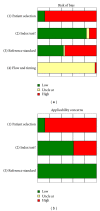Systematic Review into Diagnostics for Post-Kala-Azar Dermal Leishmaniasis (PKDL)
- PMID: 23935641
- PMCID: PMC3723149
- DOI: 10.1155/2013/150746
Systematic Review into Diagnostics for Post-Kala-Azar Dermal Leishmaniasis (PKDL)
Abstract
Identification of post-kala-azar dermal leishmaniasis (PKDL) is important due to the long and toxic treatment and the fact that PKDL patients may serve as a reservoir for visceral leishmaniasis (VL). We summarized the published literature about the accuracy of diagnostic tests for PKDL. We searched Medline for eligible studies investigating the diagnostic accuracy of any test for PKDL. Study quality was assessed using QUADAS-2. Data were extracted from 21 articles including 43 separate studies. Twenty-seven studies evaluated serological tests (rK39 dipstick, ELISA, DAT, and leishmanin tests), six studies molecular tests, eight microscopy, and two cultures. Only a few of these studies reported a valid estimate of diagnostic accuracy, as most were case-control designs or used a reference standard with low sensitivity. The included studies were very heterogeneous, for example, due to a large variety of reference standards used. Hence, no summary estimates of sensitivity or specificity could be made. We recommend well-designed diagnostic accuracy trials that evaluate, side-by-side, all currently available diagnostics, including clinical symptoms, serological, antigen, molecular, and parasitological tests and possible use of statistical modelling to evaluate diagnostics when there is no suitable gold standard.
Figures




References
-
- Zijlstra EE, El-Hassan AM. Leishmaniasis in Sudan. Post kala-azar dermal leishmaniasis. Transactions of the Royal Society of Tropical Medicine and Hygiene. 2001;95:S59–S76. - PubMed
-
- Salotra P, Singh R. Challenges in the diagnosis of post kala-azar dermal leishmaniasis. Indian Journal of Medical Research. 2006;123(3):295–310. - PubMed
-
- Zijlstra EE, Alvar J. The Post Kala-Azar dermal Leishmaniasis (PKDL) atlas. The Lancet Infectious Diseases. 2013;3(2):87–98. - PubMed
-
- Whiting PF, Rutjes AWS, Westwood ME, et al. Quadas-2: a revised tool for the quality assessment of diagnostic accuracy studies. Annals of Internal Medicine. 2011;155(8):529–536. - PubMed
LinkOut - more resources
Full Text Sources
Other Literature Sources

